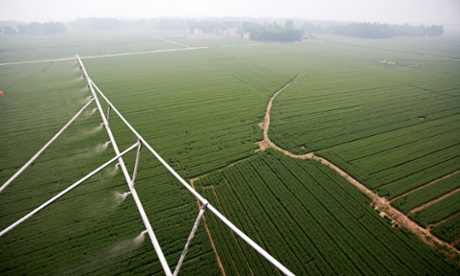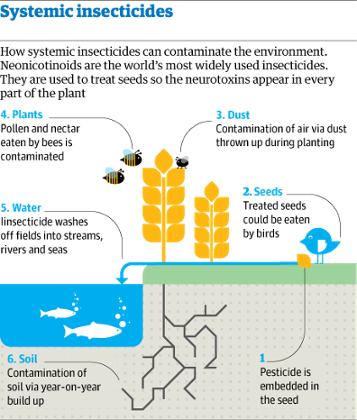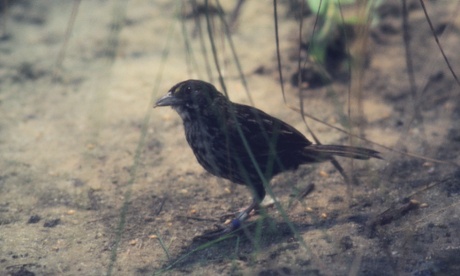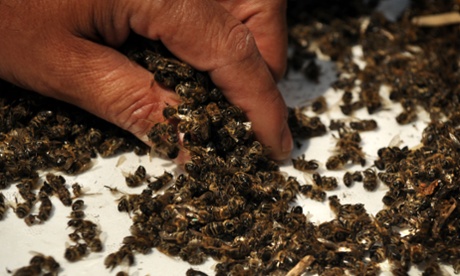Por: Damian Carrington
The Guardian, Tuesday 24 June 2014

Farmers use helicopters to spray insecticide and fertilizer on wheat crops in Henan province, China. Photograph: TPG/Getty Images
The world’s most widely used insecticides have contaminated the environment across the planet so pervasively that global food production is at risk, according to a comprehensive scientific assessment of the chemicals’ impacts.
The researchers compare their impact with that reported in Silent Spring, the landmark 1962 book by Rachel Carson that revealed the decimation of birds and insects by the blanket use of DDT and other pesticides and led to the modern environmental movement.
Billions of dollars’ worth of the potent and long-lasting neurotoxins are sold every year but regulations have failed to prevent the poisoning of almost all habitats, the international team of scientists concluded in the most detailed study yet. As a result, they say, creatures essential to global food production – from bees to earthworms – are likely to be suffering grave harm and the chemicals must be phased out.
The new assessment analysed the risks associated with neonicotinoids, a class of insecticides on which farmers spend $2.6bn (£1.53bn) a year. Neonicotinoids are applied routinely rather than in response to pest attacks but the scientists highlight the “striking” lack of evidence that this leads to increased crop yields.
“The evidence is very clear. We are witnessing a threat to the productivity of our natural and farmed environment equivalent to that posed by organophosphates or DDT,” said Jean-Marc Bonmatin, of the National Centre for Scientific Research (CNRS) in France, one of the 29 international researchers who conducted the four-year assessment. “Far from protecting food production, the use of neonicotinoid insecticides is threatening the very infrastructure which enables it.” He said the chemicals imperilled food supplies by harming bees and other pollinators, which fertilise about three-quarters of the world’s crops, and the organisms that create the healthy soils which the world’s food requires in order to grow. Systemic insecticides. Photograph: /Guim
Systemic insecticides. Photograph: /Guim
Professor Dave Goulson, at the University of Sussex, another member of the team, said: “It is astonishing we have learned so little. After Silent Spring revealed the unfortunate side-effects of those chemicals, there was a big backlash. But we seem to have gone back to exactly what we were doing in the 1950s. It is just history repeating itself. The pervasive nature of these chemicals mean they are found everywhere now.
“If all our soils are toxic, that should really worry us, as soil is crucial to food production."
The assessment, published on Tuesday, cites the chemicals as a key factor in the decline of bees, alongside the loss of flower-rich habitats meadows and disease. The insecticides harm bees’ ability to navigateand learn, damage their immune systems and cut colony growth. In worms, which provide a critical role in aerating soil, exposure to the chemicals affects their ability to tunnel.
Dragonflies, which eat mosquitoes, and other creatures that live in water are also suffering, with some studies showing that ditchwater has become so contaminated it could be used directly as a lice-control pesticide.
The report warned that loss of insects may be linked to major declines in the birds that feed on them, though it also notes that eating just a few insecticide-treated seeds would kill birds directly. One of the last living male dusky seaside sparrows is seen in this 1981 file photo while in captivity at Santa Fe Community College in Gainesville, Florida. DDT pesticide spraying since the 1940s contributed to the extinction of this species. Photograph: Nathan Benn/Corbis
One of the last living male dusky seaside sparrows is seen in this 1981 file photo while in captivity at Santa Fe Community College in Gainesville, Florida. DDT pesticide spraying since the 1940s contributed to the extinction of this species. Photograph: Nathan Benn/Corbis
“Overall, a compelling body of evidence has accumulated that clearly demonstrates that the wide-scale use of these persistent, water-soluble chemicals is having widespread, chronic impacts upon global biodiversity and is likely to be having major negative effects on ecosystem services such as pollination that are vital to food security,” the study concluded.
The report is being published as a special issue of the peer-reviewed journal Environmental Science and Pollution Research and was funded by a charitable foundation run by the ethical bank Triodos.
The EU, opposed by the British government and the National Farmers Union, has already imposed a temporary three-year moratorium on the use of some neonicotinoids on some crops. This month US presidentBarack Obama ordered an urgent assessment of the impact of neonicotinoids on bees. But the insecticides are used all over the world on crops, as well as flea treatments in cats and dogs and to protect timber from termites.
However, the Crop Protection Association, which represents pesticide manufacturers, criticised the report. Nick von Westenholz, chief executive of the CPA, said: “It is a selective review of existing studies which highlighted worst-case scenarios, largely produced under laboratory conditions. As such, the publication does not represent a robust assessment of the safety of systemic pesticides under realistic conditions of use.”
Von Westenholz added: “Importantly, they have failed or neglected to look at the broad benefits provided by this technology and the fact that by maximising yields from land already under cultivation, more wild spaces are preserved for biodiversity. The crop protection industry takes its responsibility towards pollinators seriously. We recognise the vital role pollinators play in global food production.” A Bulgarian beekeeper grabs dead bees during a demonstration in Sofia to call for a moratorium on the use of neonicotinoid pesticides in April. Photograph: Dimitar Dilkoff/AFP/Getty Images
A Bulgarian beekeeper grabs dead bees during a demonstration in Sofia to call for a moratorium on the use of neonicotinoid pesticides in April. Photograph: Dimitar Dilkoff/AFP/Getty Images
The new report, called the Worldwide Integrated Assessment on Systemic Pesticides, analysed every peer-reviewed scientific paper on neonicotinoids and another insecticide called fipronil since they were first used in the mid-1990s. These chemicals are different from other pesticides because, instead of being sprayed over crops, they are usually used to treat seeds. This means they are taken up by every part of the growing plant, including roots, leaves, pollen and nectar, providing multiple ways for other creatures to be exposed.
The scientists found that the use of the insecticides shows a “rapid increase” over the past decade and that the slow breakdown of the compounds and their ability to be washed off fields in water has led to “large-scale contamination”. The team states that current rules on use have failed to prevent dangerous levels building up in the environment.
Almost as concerning as what is known about neonicotinoids is what is not known, the researchers said. Most countries have no public data on the quantities or locations of the systemic pesticides being applied. The testing demanded by regulators to date has not determined the long-term effect of sub-lethal doses, nor has it assessed the impact of the combined impact of the cocktail of many pesticides encountered in most fields. The toxicity of neonicotinoids has only been established for very few of the species known to be exposed. For example, just four of the 25,000 known species of bee have been assessed. There is virtually no data on effects on reptiles or mammals.
The world’s most widely used insecticides have contaminated the environment across the planet so pervasively that global food production is at risk, according to a comprehensive scientific assessment of the chemicals’ impacts.
The researchers compare their impact with that reported in Silent Spring, the landmark 1962 book by Rachel Carson that revealed the decimation of birds and insects by the blanket use of DDT and other pesticides and led to the modern environmental movement.
Billions of dollars’ worth of the potent and long-lasting neurotoxins are sold every year but regulations have failed to prevent the poisoning of almost all habitats, the international team of scientists concluded in the most detailed study yet. As a result, they say, creatures essential to global food production – from bees to earthworms – are likely to be suffering grave harm and the chemicals must be phased out.
The new assessment analysed the risks associated with neonicotinoids, a class of insecticides on which farmers spend $2.6bn (£1.53bn) a year. Neonicotinoids are applied routinely rather than in response to pest attacks but the scientists highlight the “striking” lack of evidence that this leads to increased crop yields.
“The evidence is very clear. We are witnessing a threat to the productivity of our natural and farmed environment equivalent to that posed by organophosphates or DDT,” said Jean-Marc Bonmatin, of the National Centre for Scientific Research (CNRS) in France, one of the 29 international researchers who conducted the four-year assessment. “Far from protecting food production, the use of neonicotinoid insecticides is threatening the very infrastructure which enables it.” He said the chemicals imperilled food supplies by harming bees and other pollinators, which fertilise about three-quarters of the world’s crops, and the organisms that create the healthy soils which the world’s food requires in order to grow.
 Systemic insecticides. Photograph: /Guim
Systemic insecticides. Photograph: /GuimProfessor Dave Goulson, at the University of Sussex, another member of the team, said: “It is astonishing we have learned so little. After Silent Spring revealed the unfortunate side-effects of those chemicals, there was a big backlash. But we seem to have gone back to exactly what we were doing in the 1950s. It is just history repeating itself. The pervasive nature of these chemicals mean they are found everywhere now.
“If all our soils are toxic, that should really worry us, as soil is crucial to food production."
The assessment, published on Tuesday, cites the chemicals as a key factor in the decline of bees, alongside the loss of flower-rich habitats meadows and disease. The insecticides harm bees’ ability to navigateand learn, damage their immune systems and cut colony growth. In worms, which provide a critical role in aerating soil, exposure to the chemicals affects their ability to tunnel.
Dragonflies, which eat mosquitoes, and other creatures that live in water are also suffering, with some studies showing that ditchwater has become so contaminated it could be used directly as a lice-control pesticide.
The report warned that loss of insects may be linked to major declines in the birds that feed on them, though it also notes that eating just a few insecticide-treated seeds would kill birds directly.
 One of the last living male dusky seaside sparrows is seen in this 1981 file photo while in captivity at Santa Fe Community College in Gainesville, Florida. DDT pesticide spraying since the 1940s contributed to the extinction of this species. Photograph: Nathan Benn/Corbis
One of the last living male dusky seaside sparrows is seen in this 1981 file photo while in captivity at Santa Fe Community College in Gainesville, Florida. DDT pesticide spraying since the 1940s contributed to the extinction of this species. Photograph: Nathan Benn/Corbis“Overall, a compelling body of evidence has accumulated that clearly demonstrates that the wide-scale use of these persistent, water-soluble chemicals is having widespread, chronic impacts upon global biodiversity and is likely to be having major negative effects on ecosystem services such as pollination that are vital to food security,” the study concluded.
The report is being published as a special issue of the peer-reviewed journal Environmental Science and Pollution Research and was funded by a charitable foundation run by the ethical bank Triodos.
The EU, opposed by the British government and the National Farmers Union, has already imposed a temporary three-year moratorium on the use of some neonicotinoids on some crops. This month US presidentBarack Obama ordered an urgent assessment of the impact of neonicotinoids on bees. But the insecticides are used all over the world on crops, as well as flea treatments in cats and dogs and to protect timber from termites.
However, the Crop Protection Association, which represents pesticide manufacturers, criticised the report. Nick von Westenholz, chief executive of the CPA, said: “It is a selective review of existing studies which highlighted worst-case scenarios, largely produced under laboratory conditions. As such, the publication does not represent a robust assessment of the safety of systemic pesticides under realistic conditions of use.”
Von Westenholz added: “Importantly, they have failed or neglected to look at the broad benefits provided by this technology and the fact that by maximising yields from land already under cultivation, more wild spaces are preserved for biodiversity. The crop protection industry takes its responsibility towards pollinators seriously. We recognise the vital role pollinators play in global food production.”
 A Bulgarian beekeeper grabs dead bees during a demonstration in Sofia to call for a moratorium on the use of neonicotinoid pesticides in April. Photograph: Dimitar Dilkoff/AFP/Getty Images
A Bulgarian beekeeper grabs dead bees during a demonstration in Sofia to call for a moratorium on the use of neonicotinoid pesticides in April. Photograph: Dimitar Dilkoff/AFP/Getty ImagesThe new report, called the Worldwide Integrated Assessment on Systemic Pesticides, analysed every peer-reviewed scientific paper on neonicotinoids and another insecticide called fipronil since they were first used in the mid-1990s. These chemicals are different from other pesticides because, instead of being sprayed over crops, they are usually used to treat seeds. This means they are taken up by every part of the growing plant, including roots, leaves, pollen and nectar, providing multiple ways for other creatures to be exposed.
The scientists found that the use of the insecticides shows a “rapid increase” over the past decade and that the slow breakdown of the compounds and their ability to be washed off fields in water has led to “large-scale contamination”. The team states that current rules on use have failed to prevent dangerous levels building up in the environment.
Almost as concerning as what is known about neonicotinoids is what is not known, the researchers said. Most countries have no public data on the quantities or locations of the systemic pesticides being applied. The testing demanded by regulators to date has not determined the long-term effect of sub-lethal doses, nor has it assessed the impact of the combined impact of the cocktail of many pesticides encountered in most fields. The toxicity of neonicotinoids has only been established for very few of the species known to be exposed. For example, just four of the 25,000 known species of bee have been assessed. There is virtually no data on effects on reptiles or mammals.

No hay comentarios:
Publicar un comentario